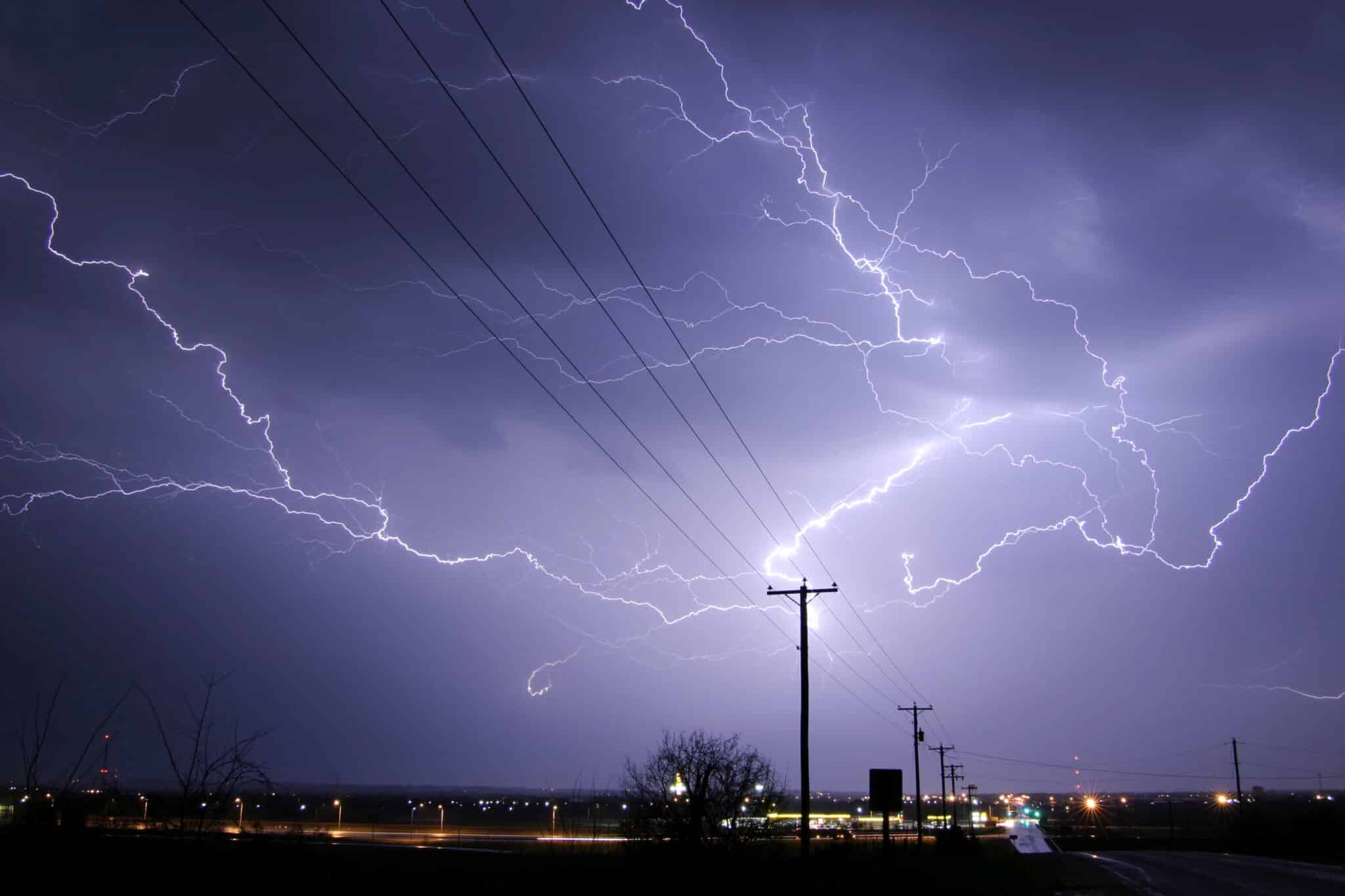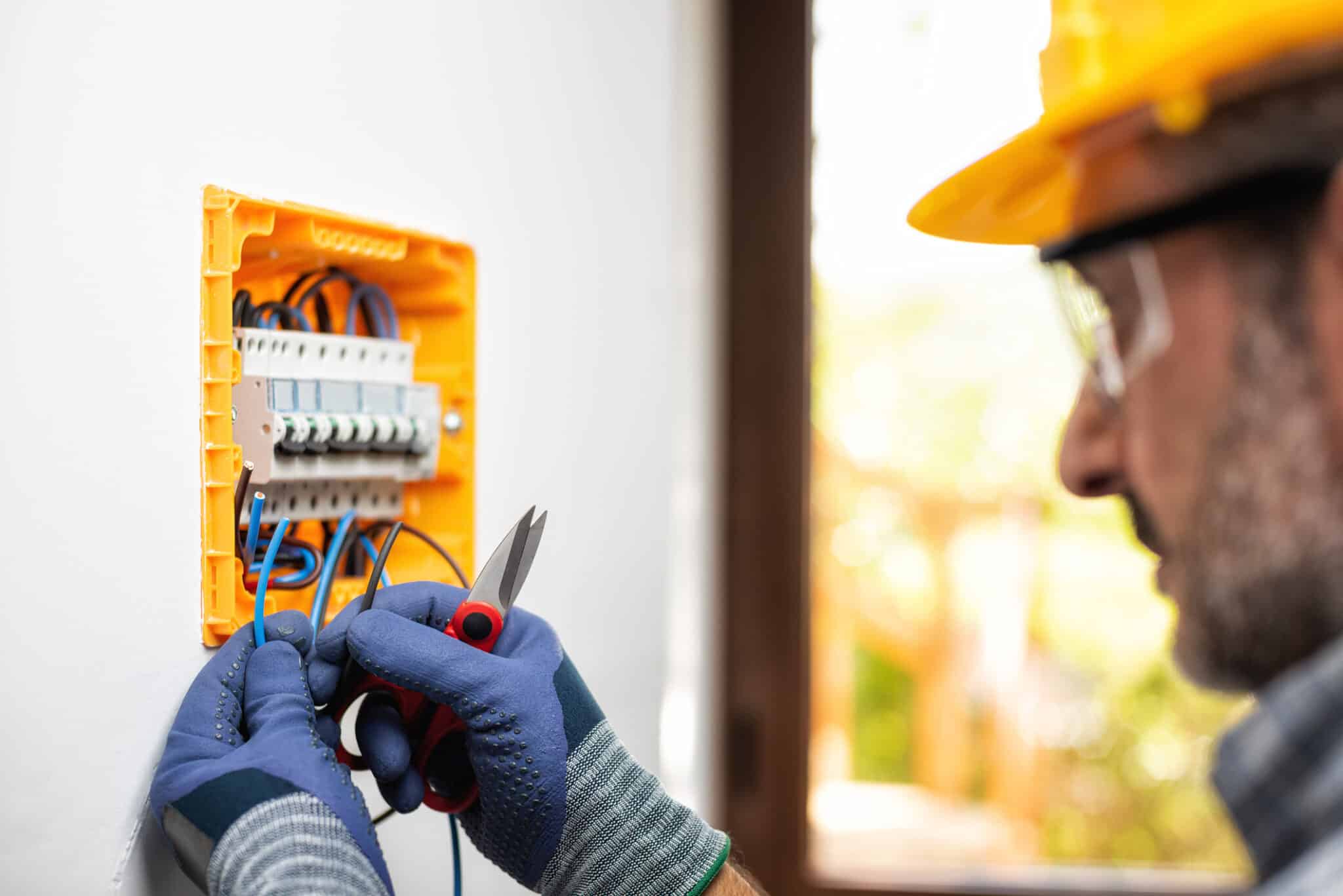Surge protection is essential as winter storms can wreak havoc on electrical systems, especially in coastal climates—are your devices protected? Living in areas like Charleston, Mt. Pleasant, or Summerville means you know how unpredictable winter weather can be.
The combination of high humidity, salty air, and frequent storms makes coastal areas more vulnerable to power surges. During the winter months, these surges become even more common, thanks to storms, downed power lines, and sudden electricity restorations.

Understanding Power Surges
What Are Power Surges?
A power surge occurs when there’s a sudden spike in electrical voltage beyond the standard levels your system is designed to handle. These surges can overload circuits, damaging appliances, electronics, and even wiring throughout your home.
The excess energy is often too much for typical devices to withstand, leading to expensive replacements or repairs. Surge protection is the most effective way to mitigate this risk and maintain the reliability of your electrical system.
Common Causes of Power Surges
Power surges can occur for a variety of reasons, but some causes are particularly common and worth understanding:
- Lightning strikes: While less frequent, lightning strikes are incredibly powerful and can send immense energy surging through your home’s wiring. Even a single strike can instantly destroy connected devices like TVs, computers, or appliances.
- Downed power lines: During storms, high winds or falling trees often bring down power lines, disrupting the normal flow of electricity. This creates instability in the system that can lead to dangerous voltage spikes in your home.
- Sudden restoration of electricity: After a power outage, the abrupt return of electricity can create surges that overload unprotected circuits. This can damage wiring and destroy electronics, sometimes without immediate signs of failure.
- Internal electrical issues: Even within your home, devices like refrigerators and Heating and AC systems can cause small, frequent surges when they cycle on and off, leading to long-term wear on your electrical system.
Understanding these causes is the first step in preventing costly damage. Implementing proper safeguards ensures your home and electronics are protected from both small, gradual surges and large, catastrophic ones.
Why Coastal Climates Are More Vulnerable
Coastal climates experience environmental factors that increase the likelihood of power surges, making surge protection even more essential. High humidity accelerates the deterioration of electrical components, weakening your system over time. Salt from the ocean air contributes to corrosion, which can damage wiring and reduce efficiency.
Frequent storms and high winds further compound these risks, as they lead to more frequent power outages and sudden voltage spikes. These unique challenges make it vital for homeowners in coastal areas to invest in reliable surge protection strategies.
Why Surge Protection Is Essential During Winter
Preventing Damage to Electronics
Surge protection is a crucial safeguard for your valuable electronics, especially during the winter months when power surges are more frequent. Devices like computers, TVs, gaming consoles, and smart home gadgets are particularly vulnerable to sudden voltage spikes.
Without protection, even a small surge can fry internal components, rendering the device unusable and costing you hundreds of dollars in replacements. By installing surge protectors, you can shield these electronics from harm and prolong their lifespan.
Avoiding Electrical Fires
Electrical fires are a dangerous consequence of unchecked power surges, especially in older homes or homes with outdated wiring. When a surge occurs, the sudden overload of electricity can cause circuits to overheat and, in severe cases, spark a fire.
Coastal areas with high humidity and salt exposure are more prone to wiring damage, increasing this risk further. Surge protectors act as a barrier, cutting off excessive voltage before it can cause overheating, thus reducing the likelihood of fires during winter storms.
Minimizing Costly Repairs
Power surges don’t just harm individual devices; they can wreak havoc on your home’s entire electrical system. Replacing appliances, repairing circuits, or repairing damaged wiring can quickly become an expensive ordeal.
With the right surge protection measures in place, you can avoid these costly repairs and maintain a more reliable electrical setup. Investing in surge protection upfront is far more economical than dealing with the fallout of a major surge event.
Types of Surge Protectors
Whole-Home Surge Protectors
Whole-home surge protectors provide comprehensive coverage by guarding your entire electrical system against sudden voltage spikes. These devices are installed directly at the main electrical panel, intercepting surges before they can reach your outlets and connected devices.
This solution is particularly effective for homes in coastal areas like Charleston, where frequent storms increase the risk of surges. Whole-home protectors are a smart investment for long-term safety and peace of mind, especially for households with numerous electronic devices and appliances.
Point-of-Use Surge Protectors
Point-of-use surge protectors are plug-in devices designed to protect specific electronics, such as your TV, computer, or gaming system. These are ideal for sensitive or high-value items that need an extra layer of defense against power surges.
Unlike whole-home protectors, these are more affordable and can be easily replaced if needed. For maximum effectiveness, it’s essential to choose high-quality, UL-certified surge protectors that can handle the voltage demands of modern electronics.
Power Strips vs. Surge Protectors
It’s important to understand the difference between basic power strips and surge protectors, as they’re often confused. A power strip simply provides extra outlets but offers no protection from surges, leaving your devices exposed to damage.
Surge protectors, on the other hand, are designed to absorb and redirect excess voltage, safeguarding your equipment. When shopping, look for surge protectors with a joule rating listed, as this indicates their capacity to handle surges.
Advanced Surge Protection Devices
For those seeking cutting-edge solutions, advanced surge protectors with smart features are now available. These devices often include built-in monitoring systems that track electrical flow and alert you to any issues in real-time.
Some models can even be integrated with smart home systems, offering remote control and detailed diagnostics. Advanced surge protection is a great choice for tech-savvy homeowners who want to ensure maximum safety and efficiency.
How to Protect Your Home From Winter Surges
Install a Whole-Home Surge Protector
A whole-home surge protector is one of the most reliable ways to shield your home from the dangers of winter power surges. Installed at your main electrical panel, it stops voltage spikes before they can reach your outlets and appliances.
This type of protection is especially valuable for homes in storm-prone coastal areas like Charleston, Mt. Pleasant, and Summerville. With a whole-home surge protector, you can rest easy knowing your electrical system and connected devices are safeguarded around the clock.
Use High-Quality Point-of-Use Protectors
For added protection, use high-quality point-of-use surge protectors for your most valuable electronics. Devices such as TVs, gaming systems, and computers are particularly sensitive to power surges and can benefit from the extra defense.
When choosing surge protectors, look for UL certification and a high joule rating to ensure they can handle significant voltage spikes. Investing in durable, reputable products will provide peace of mind and save you from costly replacements down the road.
Unplug Unused Devices During Storms
A simple yet effective way to protect your electronics is to unplug non-essential devices during winter storms. This eliminates any risk of a surge damaging your equipment, especially if the storm causes sudden power outages or flickering.
Focus on unplugging items like chargers, small appliances, and entertainment systems when they’re not in use. This small step not only protects your devices but also helps conserve energy.
Inspect Your Electrical System
Regularly inspecting your home’s electrical system is essential for minimizing the risk of surge damage. Look for signs of outdated wiring, such as flickering lights or frequently tripped breakers, which could make your system more vulnerable.
Scheduling an inspection with a professional electrician can help identify and address potential weak points. Keeping your electrical system in top condition is a proactive way to stay protected during the unpredictable winter season.
Maintaining Surge Protection Equipment
Regularly Test Surge Protectors
To ensure your surge protectors are functioning effectively, it’s important to test them regularly. Many modern surge protectors have indicator lights that show whether they’re still operational.
If the light is off or flickering, it may be a sign that the device has worn out or stopped working due to previous surges. Replacing worn-out surge protectors promptly will help maintain the safety of your electronics and prevent unexpected damage during power surges.
Upgrade Outdated Devices
Older surge protectors may not offer the same level of durability or efficiency as newer models. Technology evolves, and modern surge protectors are designed to handle higher energy loads while offering additional features like smart monitoring.
If your surge protectors are several years old, consider upgrading to models with higher joule ratings or advanced safety mechanisms. Upgrading ensures your home remains well-protected against the increasing risks of winter power surges.
Inspect for Damage After Storms
After severe winter storms, it’s essential to inspect your surge protectors and electrical system for any signs of damage. Look for burn marks, melted parts, or unusual smells coming from your surge protectors, as these could indicate that they’ve absorbed a surge.
Additionally, check your wiring for visible issues like fraying or corrosion. Addressing storm-related damage quickly can help you avoid bigger electrical problems and keep your system running safely.
Signs Your Home Needs Surge Protection
Frequent Circuit Breaker Trips
If your circuit breakers are tripping more often than usual, it could be a sign that your electrical system is unstable and experiencing power surges. Breakers are designed to cut off power during overloads to prevent damage, but frequent trips may indicate an underlying issue.
Coastal climates, with their exposure to salty air and high humidity, can exacerbate electrical instability. Installing surge protection can help stabilize your system and reduce the frequency of these disruptions.
Flickering Lights
Flickering lights are another common indicator of power surges or overloaded circuits. While a single flicker may not seem alarming, frequent or prolonged flickering can signal a serious problem.
Coastal homes are particularly susceptible to these issues due to environmental wear on electrical components. Surge protectors can help prevent these fluctuations, ensuring consistent power flow and avoiding potential damage to your wiring and appliances.
Unexplained Device Failures
If your appliances or electronics suddenly stop working without an obvious reason, a power surge could be to blame. Surges can damage the internal components of devices, causing them to fail prematurely.
This is especially true for sensitive electronics like computers, TVs, and smart home devices. Adding surge protection to your home can prevent these unexpected failures, saving you the hassle and expense of replacing damaged equipment.
Long-Term Benefits of Surge Protection
Safeguards Your Investments
Surge protection is a smart way to protect the money you’ve spent on your electronics and appliances. Devices like computers, TVs, refrigerators, and gaming consoles are expensive, and replacing them after a power surge can be a significant financial burden.
Surge protectors act as a shield, absorbing or deflecting excess voltage before it can damage your equipment. By investing in surge protection, you ensure that your valuable items are safe from unexpected power surges, extending their lifespan and saving you money over time.
Peace of Mind
Knowing that your home and electronics are protected from power surges provides invaluable peace of mind, especially during stormy winters. Coastal areas like Charleston, Mt. Pleasant, and Summerville are no strangers to unpredictable weather, which makes surge protection even more important.
With the right equipment in place, you can relax during storms without worrying about damage to your appliances or electrical system. This sense of security is one of the most significant benefits of installing surge protection in your home.
Energy Efficiency
Surge protection not only guards your electronics but also helps them run more efficiently. Electrical surges, even small ones, can strain your devices over time, causing them to draw more power to function properly.
By stabilizing the electrical flow, surge protectors prevent this strain, helping your appliances and electronics operate more efficiently. Over time, this can reduce your energy consumption and lower your utility bills, making surge protection a cost-effective choice for your home.

Professional Surge Protection Services
Why Hire an Electrician?
While some surge protection solutions, like point-of-use protectors, are easy to implement, more comprehensive options require professional installation. Electricians have the expertise to assess your home’s electrical system and recommend the best surge protection strategies.
Installing a whole-home surge protector, for instance, involves connecting the device to your main electrical panel, a job best handled by a professional. Hiring an electrician ensures the work is done safely, efficiently, and in compliance with local codes, especially important in coastal regions with unique electrical challenges.
Custom Solutions for Coastal Homes
Homes in coastal areas like Charleston, Mt. Pleasant, and Summerville face unique risks that require tailored surge protection strategies. High humidity, salty air, and frequent storms can accelerate wear on electrical systems, increasing the likelihood of surges.
Professional electricians can recommend solutions specifically designed for these conditions, such as corrosion-resistant surge protectors and advanced monitoring systems. Customized approaches ensure your home remains protected, no matter how harsh the winter weather gets.
Protect Your Home This Winter with Expert Electrical Solutions
Winter storms can strike anytime—don’t leave your home and electronics at risk. Mister Sparky of Charleston is here to help residents in Charleston, Mt. Pleasant, and Summerville stay safe and secure with professional electrical services tailored to coastal climates.
From whole-home protection to addressing outdated wiring, our professional electricians ensure your home is prepared for anything winter throws your way. Contact Mister Sparky of Charleston today to schedule your service and take the first step toward a safer, worry-free home this winter.
Frequently Asked Questions (FAQ)
How do I know if my surge protector is working?
Most modern protectors have an indicator light that shows whether the device is functioning. If the light is off or flickering, it might be time to replace it. Regularly checking this light can help ensure your equipment is always protected.
Can a power strip replace a surge protector?
No, a power strip only adds extra outlets and doesn’t provide protection against voltage spikes. For safety, always use a dedicated protector with built-in voltage regulation for sensitive or valuable devices.
How often should I replace my surge protector?
It depends on the device and how many spikes it has absorbed, but a good rule of thumb is every three to five years. If your area experiences frequent storms or outages, you may need to replace them sooner.
Do whole-home devices protect everything?
Whole-home protectors provide a broad defense by stopping surges at the main panel, but smaller plug-in devices are still recommended for sensitive electronics. Combining both types of protection gives you the best results.
What should I do after a power surge?
Inspect your devices and protectors for signs of damage, such as burn marks or unusual smells. If you notice any issues, unplug the affected devices and consult a professional electrician to assess your system.






